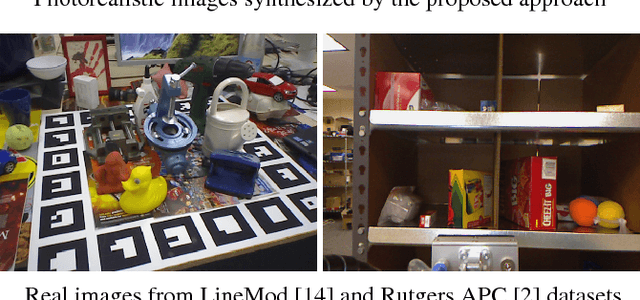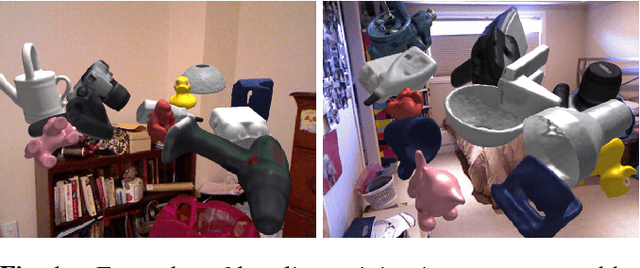Brian Guenter
Photorealistic Image Synthesis for Object Instance Detection
Feb 09, 2019



Abstract:We present an approach to synthesize highly photorealistic images of 3D object models, which we use to train a convolutional neural network for detecting the objects in real images. The proposed approach has three key ingredients: (1) 3D object models are rendered in 3D models of complete scenes with realistic materials and lighting, (2) plausible geometric configuration of objects and cameras in a scene is generated using physics simulations, and (3) high photorealism of the synthesized images achieved by physically based rendering. When trained on images synthesized by the proposed approach, the Faster R-CNN object detector achieves a 24% absolute improvement of mAP@.75IoU on Rutgers APC and 11% on LineMod-Occluded datasets, compared to a baseline where the training images are synthesized by rendering object models on top of random photographs. This work is a step towards being able to effectively train object detectors without capturing or annotating any real images. A dataset of 600K synthetic images with ground truth annotations for various computer vision tasks will be released on the project website: thodan.github.io/objectsynth.
Highly curved image sensors: a practical approach for improved optical performance
Jun 20, 2017



Abstract:The significant optical and size benefits of using a curved focal surface for imaging systems have been well studied yet never brought to market for lack of a high-quality, mass-producible, curved image sensor. In this work we demonstrate that commercial silicon CMOS image sensors can be thinned and formed into accurate, highly curved optical surfaces with undiminished functionality. Our key development is a pneumatic forming process that avoids rigid mechanical constraints and suppresses wrinkling instabilities. A combination of forming-mold design, pressure membrane elastic properties, and controlled friction forces enables us to gradually contact the die at the corners and smoothly press the sensor into a spherical shape. Allowing the die to slide into the concave target shape enables a threefold increase in the spherical curvature over prior approaches having mechanical constraints that resist deformation, and create a high-stress, stretch-dominated state. Our process creates a bridge between the high precision and low-cost but planar CMOS process, and ideal non-planar component shapes such as spherical imagers for improved optical systems. We demonstrate these curved sensors in prototype cameras with custom lenses, measuring exceptional resolution of 3220 line-widths per picture height at an aperture of f/1.2 and nearly 100% relative illumination across the field. Though we use a 1/2.3" format image sensor in this report, we also show this process is generally compatible with many state of the art imaging sensor formats. By example, we report photogrammetry test data for an APS-C sized silicon die formed to a 30$^\circ$ subtended spherical angle. These gains in sharpness and relative illumination enable a new generation of ultra-high performance, manufacturable, digital imaging systems for scientific, industrial, and artistic use.
A Statistical Approach to Continuous Self-Calibrating Eye Gaze Tracking for Head-Mounted Virtual Reality Systems
Dec 20, 2016



Abstract:We present a novel, automatic eye gaze tracking scheme inspired by smooth pursuit eye motion while playing mobile games or watching virtual reality contents. Our algorithm continuously calibrates an eye tracking system for a head mounted display. This eliminates the need for an explicit calibration step and automatically compensates for small movements of the headset with respect to the head. The algorithm finds correspondences between corneal motion and screen space motion, and uses these to generate Gaussian Process Regression models. A combination of those models provides a continuous mapping from corneal position to screen space position. Accuracy is nearly as good as achieved with an explicit calibration step.
Lens Factory: Automatic Lens Generation Using Off-the-shelf Components
Jul 16, 2015



Abstract:Custom optics is a necessity for many imaging applications. Unfortunately, custom lens design is costly (thousands to tens of thousands of dollars), time consuming (10-12 weeks typical lead time), and requires specialized optics design expertise. By using only inexpensive, off-the-shelf lens components the Lens Factory automatic design system greatly reduces cost and time. Design, ordering of parts, delivery, and assembly can be completed in a few days, at a cost in the low hundreds of dollars. Lens design constraints, such as focal length and field of view, are specified in terms familiar to the graphics community so no optics expertise is necessary. Unlike conventional lens design systems, which only use continuous optimization methods, Lens Factory adds a discrete optimization stage. This stage searches the combinatorial space of possible combinations of lens elements to find novel designs, evolving simple canonical lens designs into more complex, better designs. Intelligent pruning rules make the combinatorial search feasible. We have designed and built several high performance optical systems which demonstrate the practicality of the system.
 Add to Chrome
Add to Chrome Add to Firefox
Add to Firefox Add to Edge
Add to Edge